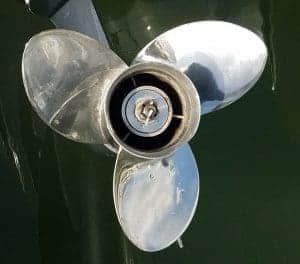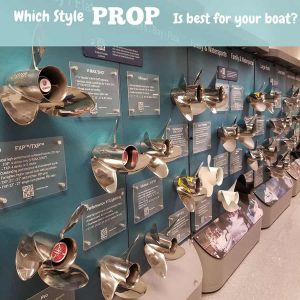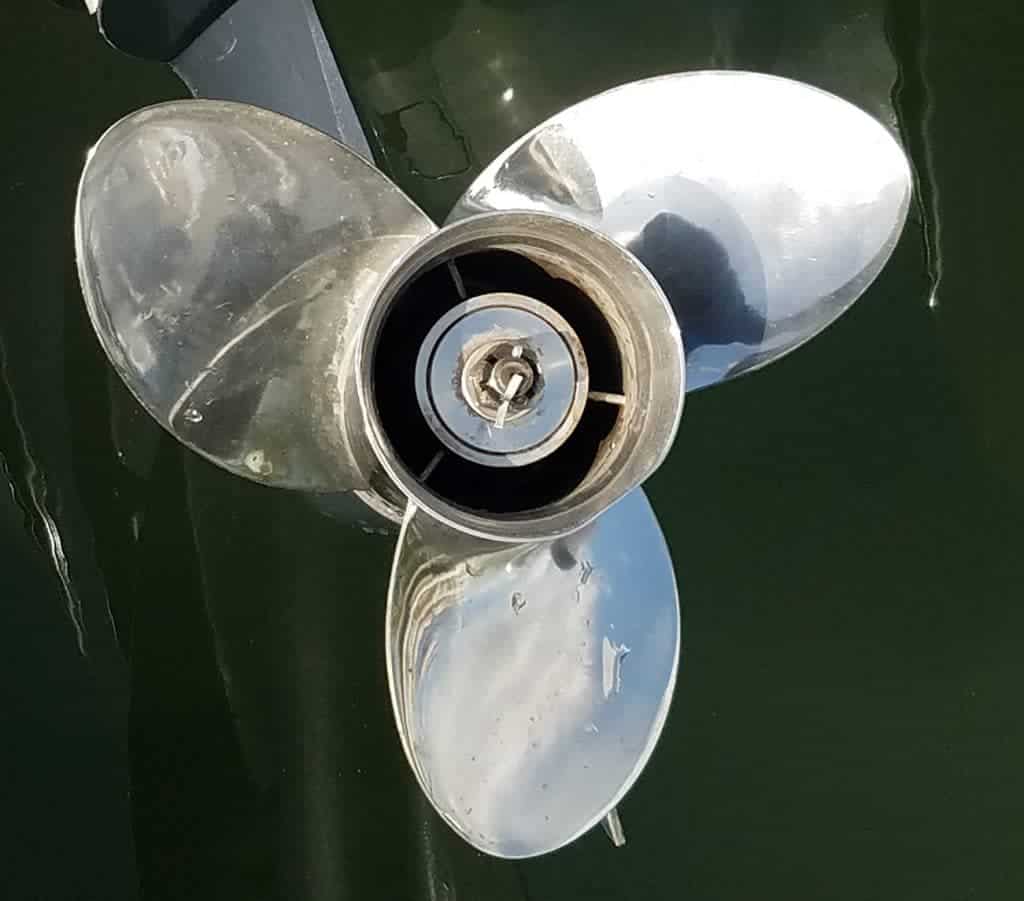How having a proper, suitable prop for your boat can make all the difference between a properly functioning craft, huge repair costs, stress-free boating, and a complete wallet-vandalizing nightmare!
Does Your Boat Have The Right Propeller? When it comes to propping a boat, there isn’t a “one-size-fits-all” approach. Determining the correct size propeller for your boat comes down to your boat’s specific RPM range, rev limiter setting and what the purpose of your boating is.
Determining the correct size prop for your boat comes down to your boat’s specific RPM range, rev limiter setting and what the purpose of your boating is.
Prop Pitch Explained
Props are to a boat what wheels are to a car. They come in all types of styles, shapes, sizes, and materials. Ranging from smaller to larger props, twin-blade to six-blade, and more.
Truly understanding how props work is paramount to the life of your boat, it’s fuel consumption and its overall performance.
A propeller is measured in diameter and in pitch. The diameter, like that of a circle, is how big around the prop is.
The pitch is defined as the “theoretical distance” the prop will move through the water in one revolution, or turn.
For example, a 19 pitch prop is theoretically going to move 19 inches through the water in one single revolution. Now, imagine the equivalent distance (19 inches per turn of the prop) at 6,000 RPMs!
That’s slicing through the water! It’s important to keep the key term in mind here – theoretical distance. If it wasn’t theoretical, we would go as far as saying “the bigger the pitch, the better the prop”. However, this is not the case here.
The Meaning of The Numbers On A Prop
Typically, most propellers will have specific information engraved on them. This information usually consists of two to four sets of numbers and letters.
One being the propeller diameter, the second being the pitch length, third representing the rotational direction and fourth being the bore/shaft diameter.
An example of these numbers displayed resembles the following: 15.6 x 15 | RH | 1 ¼”
Decoded, this identifies this prop as having a 15.6” diameter with a 15” pitch, the prop rotates clockwise (to the right) and has a shaft diameter of 1 ¼”.
Are More Blades On A Prop Better?
Contrary to popular belief, many boaters think that propping their boat with a prop containing more blades equates to better performance. To an extent, this is true. However, we have to consider several other variables such as the physics of the boat, propeller, and the water.
The more a boat is submerged in the water, the more drag is created. In turn, the more contact we have with the water, the better overall control we have of the boat. Nevertheless, more water contact also means slower boat speeds.
This concept also applies to the number of blades that the prop contains; the more blades a prop has, the more drag it creates, in turn giving us a lower top-end wide throttle speed.
Running the correct prop, in the long run, is going to save you some money because it improves your mid-range cruising performance. If you are running a small prop, you will burn more fuel running higher RPMs in order to stay on plane at a decent speed.
Running too big of a prop, on the other hand, means that you will never hit wide-open throttle and this will eventually lead to carbon build up along with poor performance.
With the correct prop, we can cruise at the optimal mid-range RPM while simultaneously burning the least amount of fuel possible. A win-win for both your fun, wallet, and boat!
Is a 3 or 4 Blade Prop Better?
If we had a dollar for every customer support inquiry we receive asking whether a 3 or 4 blade prop is better, we’d be giving away free boats! It’s important to note, we are talking specifically about the average recreational boating and fishing application here.
This prop advice is not related to racing. Although the physics don’t change, there are a ton of other variables to consider for racing that is not listed here.
Pros & Cons of A 4 or 3 Blade Prop
 For us, if we go from a three blade to a four-blade without changing the diameter or pitch of the prop, we will lose top-end speed. What we will gain, however, is our hole shot (also known as the time it takes to get the boat out of the water).
For us, if we go from a three blade to a four-blade without changing the diameter or pitch of the prop, we will lose top-end speed. What we will gain, however, is our hole shot (also known as the time it takes to get the boat out of the water).
Meaning we will be out of the water and cruising much quicker thanks to the extra blade generating a better grip from the prop to the water.
With the extra grip also comes better control and handling of our craft. Understanding these simple concepts is the crucial base foundation for us to begin the propping procedure to get the correct prop for your boat.
At the end of the day, it is ultimately up to you and what you are looking to get from your boat. Would you rather have a better hole shot or top-end speed?
It’s your call! Personally, running larger boats close to the 30-foot range or higher calls for a 4 blade as its best for the size and weight of the boat. That extra blade really makes a notable difference in getting the boat out of the water and controlling it at higher speeds!
21 Pitch Vs. 19 Pitch Prop
Again, we want to make sure that you are really understanding the foundational principles of propping your boat. The only way to determine the correct prop is through good ol’ trial and error.
Swapping and testing different props until you identify the sweet spot in relation to your RPM range and limiter setting.
Each engine has a specific top-end wide open throttle RPM range. Each engine manufactured in the last 20 years will also have the rev limiter (which isn’t as important to know as much as the former).
If we put a small diameter prop on an engine with a low pitch. What will most likely happen is the power of the engine will overpower the ability of the propeller.
To grip the water and push the boat.
The result is the engine RPM’s going above the specs and hitting the rev-limiter. It’s exactly like what happens when the prop hub gets spun (gives me the shakes just thinking about it!)
On the opposite end of the spectrum, if were to install a prop with too big of diameter and pitch, then the engine won’t have enough power to spin the propeller up to the right RPM range.
Causing the engine to never reach wide-open throttle and if ran like this for a long period of time, can eventually wear out internal components of the engine prematurely.
It’s important to note that there are methods of getting propellers to turn up higher without changing the prop. This is usually done by “venting” the propeller – some props have venting holes towards the bottom of the prop.
These holes can be either plugged or have the plugs taken out allowing water to flow freely through the prop without having to be pushed off the blades of the prop, causing force against it.
How To Choose The Right Prop For Your Boat
Let’s discuss some real-life numbers, shall we?
We’ve learned about RPM ranges, rev limiters, prop pitches and diameters as well as multi-blade props. As mentioned earlier, when it comes to propping your boat, it all comes down to testing. We have to make an educated guess of which prop to start with, then test the boat and go from there.
Before we begin messing with our boat, we have to take some factors into consideration such as the weight of the boat. The conditions of the boat make all the difference.
You can prop out a boat with a fraction of your gas tank full. But taking it out under normal conditions will throw your propping calculations off kilt.
The reason being is when propping a boat, we typically forget to account for the weights of multiple passengers, amount of fuel, coolers, equipment, provisions, etc.
After all, is said and done, you could easily be adding an additional 2,000 lbs of weight. So, that prop that was previously spinning at, let’s say, 5,800 RPM is not only turning up 55, 54 or maybe even 5200 RPMs.
Bad news.
This means we are no longer propped out correctly. Remember, it’s the size and weight of the boat that the engine and prop have to push that determines the specs of the prop!
We can pick a prop based on the recommended propeller from the factory or manufacturer of the boat. We can also use the previous prop that we were running in a repower situation, or just for trying. We’ll install the prop and take the boat out for a test drive.
Let’s say we have a 15-inch diameter prop with a 15 pitch. Our engine RPM range is 5000 to 6000 RPM’s and we’ve got close to the right amount of weight on board that we will normally have.
At wide-open throttle, our engine turns 6300 RPM’s and is hitting the rev limiter. This means that our prop is too small and isn’t big enough to push the weight of the boat.
So, we can swap out that prop for, say, a 15.5-inch diameter and a pitch of 23. After taking the boat back out, this time we only turned up to 5400 RPMs. Now the prop is too big!
Given these numbers, we can maintain that diameter prop and go back down to the 21 pitch – we will then be looking at getting roughly 58-5900 RPMs. Which means that we have found the right prop!
It’s also important to note the details regarding trimming up during this process…
Normally you won’t have the boat fully loaded when propping it out.
It’s best to prop it out towards the top end of the RPM range without trimming the engine. We want to be able to add some trim to the engine and come really close to hitting the rev limiter under these conditions.
This is because whenever we load the boat up and take it out under normal conditions. There will still be room to add some trim at wide-open throttle and have the RPM’s come all the way up to the top of the RPM range.
If we have to trim up the engine to get to the top of the range, then after we load the boat. We won’t be able to get to the top of the range because of the additional weight that has been added to the boat.
That’s all for now folks! Now that you have a better idea of how to correctly prop your boat for the best results. Remember to share this article with a fellow boater! We also encourage you to check out one of these other helpful articles that we have written!
How To Rent A Boat: Don’t Get Taken To The Cleaners! Know This!
Outboard Jack Plates, Everything You Need To Know!
What To Do When Rope or Line Wraps Around Your Propeller
Can A Bent Prop Be Repaired: Should You Repair Or Replace?
Also, check us out on our YouTube Channel where we cover all kinds of How-To and DIY boating projects! That will teach you more and more about your boat and how it works!
See you on the water!

